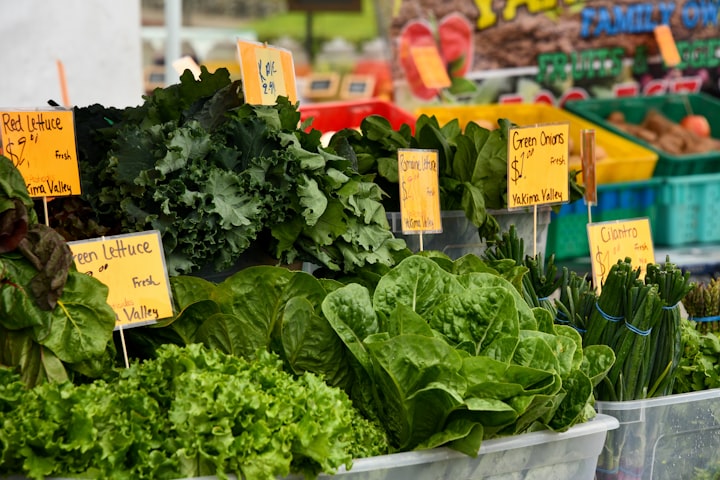Creating a sustainable grocery budget
Serving Sizes Save Cents

When we first purchased our townhouse in Southern California with its 200 square foot backyard I had visions of starting my own victory garden full of vegetables, herbs, and fruit trees. I thought that we could preserve the surplus and enjoy nature’s bounty for much less than what we were paying at the grocery store. How wrong I was! While gardening has many benefits, saving money is not one of them. After spending money on amending the soil, plants and seeds themselves, fertilizing, and water, every tomato, squash, and bean became more expensive than the organic asparagus in Whole Foods!
Now, we live on a sprawling 3 1/2 acre homestead with a fruit orchard, vineyard, olive grove, veggie patch, beehive and chicken coop. The water bill wipes out any savings at the grocery store, but the quality of life can't be beat. Even with our hobby farm, we still rely on grocery shopping for 2/3 of our consumables budget. This article will show you how we have been able to whittle down our budget both in California and South Australia by using some sustainability and budgeting guidelines.

Serving Sizes Save Cents
How can you save money and have an instant diet without paying Weight Watchers or Jenny Craig? If you focus on serving sizes and don’t overeat at restaurants, you will find that your savings add up while your waistline slims down.
If you look on the back of most food containers, you can find serving size information. On many cans and boxes, even soft drink cans, you will discover that there is more than one serving inside. Rather than eating more than your fill, why not repackage it in reusable containers and eat the remainder in a different meal. This gets tricky when dealing with soft drinks. You are better off keeping a 2 liter bottle at home and drinking it as needed instead of drinking from cans.
In many restaurants (not fast food), serving sizes are always enough for 2 to 3 people. The prices are inflated to match these serving sizes.
My friend has come up with a clever way to describe serving sizes when she eats at a restaurant. She will hold up her two fists next to each other. She then explains that this is the size of her stomach. As long as she does not eat more than her two fists, she will not overeat. She is a beautiful size 2 (American).
You can save instant money by splitting your entrees and appetizers, but make sure you read the menu to avoid paying a splitting fee. For restaurants that enforce splitting fees, you should go ahead and buy the entire entrée and then only eat as much as the size of your two fists. Then, ask for a to-go container. When you get home, separate the contents into 2 containers if you have enough left over for two servings. Voila! Now, the cost of one meal is spread over 3 meals.
99 Cent Stores
When you are in almost any town in the USA, be sure to visit a 99 Cent Store. These stores don’t sell anything for more than 99 cents. They sell vegetables, canned and boxed food, cleaning supplies, gift supplies, automotive goods, giftware, storage solutions, and seasonal items. If you’ve never been to a 99-Cent Store, you are in for a treat. I don’t recommend going out of town only to shop at these stores though, because you will waste money on gas as well as wear on your car. Instead, plan on visiting these stores when you have a trip already planned to the area. The best deals in the store are for cleaning supplies. You will end up buying the store brand, but in my experience it is just as good as the name brand supplies. If you live in a different country, be sure to seek out discount stores such as Costco or Cheap as Chips to tap into the savings.
Hunting and Gathering
Growing your own produce almost never saves you money. However, there are some exceptions to this rule. Anyone who has ever grown zucchini knows what I am talking about. If you have a sunny spot in your garden, you can plant one or two zucchini plants and end up with more zucchini than you, your family, and neighbors could eat. I’ve heard of stories of soup kitchens turning away these wonderful vegetables. Another food that tastes better from your own garden is the tomato. Tomatoes from your garden have not been subjected to the harsh conditions of transportation and refrigeration that store-bought tomatoes go through. Your home grown tomatoes will have much more flavor. If you live in an apartment with a sunlit porch or patio, buy the largest pot that you can and plant it with cherry tomatoes.
My grandmother did this when I was growing up in Galveston, Texas, and I’ll never forget the sauces and salads she made in August from her little garden. In addition to these vegetables, you should also invest in hardy herbs such as rosemary, thyme, oregano, and lemongrass. They live for years, and can be expensive to buy at the market. Annual herbs such as cilantro and basil are also a good bet in your garden, but you will end up buying a new plant every year as you harvest it for pesto and tomato/basil salads.
Now that we live on a hobby farm, we also have the room to grow all of our own fruits. Every fruit tree produces close to 100lbs of fruit which is more than enough for our family of three. In full disclosure though, our water bills run around $300 in the summertime. All of the food on the property is Non GMO and organic so we are likely breaking even compared to what we would spend in the stores. We have the added bonuses though of being able to watch the bird life and kangaroos enjoy the bounty too, and abundant free exercise as we tend to the property.
We also forage for leafy greens such as dandelion, plantain, violet, and fennel for our springtime salads which provides us a free treat every week.
Farmer's Markets
Visiting a farmer’s market is not just shopping; it is also an entertaining diversion. As you walk along the stalls, your senses are overloaded with fresh smells, bright fruits, vegetables and flowers, tastes of samples given by the farmers, and music from street musicians.
The California farmer’s markets are not less expensive than the grocery stores if you purchase food in the circulars. However, in Santa Barbara, almost all of the produce found at the farmer’s markets is organic, and picked within 24 hours of it being in the field. In recent years, the farmer’s markets have started to add olive oil, cheese, eggs, crabs, pastries, honey, and other items to their selection.
Here in Adelaide, we visit the Central Markets which is an indoor collection of produce, cheese, wines, and meats from throughout Australia. Generally, you can find much better value by shopping directly from the butcher, baker, and farmer here than in a grocery store, because they aren't pigeonholed into providing the perfect produce that is required by the major grocery stores.
The best time to go to the Farmer’s markets is within an hour of closing. The farmers are motivated to move their produce, since they do not want to bring it back to the farm. You can expect to get bags of produce that may be blemished but still tasty. The best deal is on stone fruit such as apricots, nectarines, and peaches. These fruits are very tender, so they blemish easily. If you are planning on making a pie or a luscious dessert with the fruits on the same day, you can often pick up a large bag of these fruits for $1 at the end of the day.
Grocery Stores
One way to save over 25% of your grocery budget is to shop at more than one store for your grocery list. This may seem counter intuitive, but if you shop the sales, you will find that they are complementary rather than competitive. If you shop around the perimeter, you will always save money.
Grocery stores around the world run a ‘whole chicken special’ at least once per month. Why not pick up a discounted chicken, cook it and eat it for 2 days. Next, separate out the meat from the bones and, separate into 3 piles. 1st pile: make chicken enchiladas. Second pile, make chicken casserole. Third pile is reserved for chicken sandwiches. 4th free meal, chicken noodle soup. Voila! You have meals for a week off of a $5 bird. is where the most nutritious and most sustainable food is located.
Then, there is Costco. Unless you are buying for a large family, the best way to save money at Costco is to go with a friend and split your purchases. Some of the best buys at Costco include paper products, cat litter, coffee (the best in town because it is roasted daily), spices, film, batteries, and vegetables. Be sure to analyze if you will quickly offset the cost of the membership with your savings before you invest in a Costco card.
Here are some of the best times to purchase seasonal items in North America:
October: The best time to buy candy and pumpkins, It is harvest time, so many other vegetables are on sale too.
December and January are the best times to purchase pork. Buy the pork butt for under a dollar a pound and tenderloin for $1.99lb. Ham is often sold for $0.79lb. or less between Thanksgiving and Christmas.
Stock up on turkeys between Thanksgiving and Christmas.
March specials: If you have a touch of the Irish in you, you’ll appreciate a good cut of Corned Beef. Just think of the possibilities: Corned Beef and Cabbage, Corned Beef sandwiches, Corned Beef Hash, and the list goes on. If you decide to slow-cook this dish, be sure to keep the liquid. After you have de-fatted the liquid, you can use it instead of water for bean dishes created from dried beans.
I hope you've enjoyed these sustainable, cost cutting measures. I'd love to hear what you think!
About the Creator
Monique Littlejohn
Monique Littlejohn is an artist, photographer, and writer living on a hobby farm in South Australia. She shifted between Southern California and Australia for a few years before making Stirling her permanent home 4 years ago.






Comments
There are no comments for this story
Be the first to respond and start the conversation.